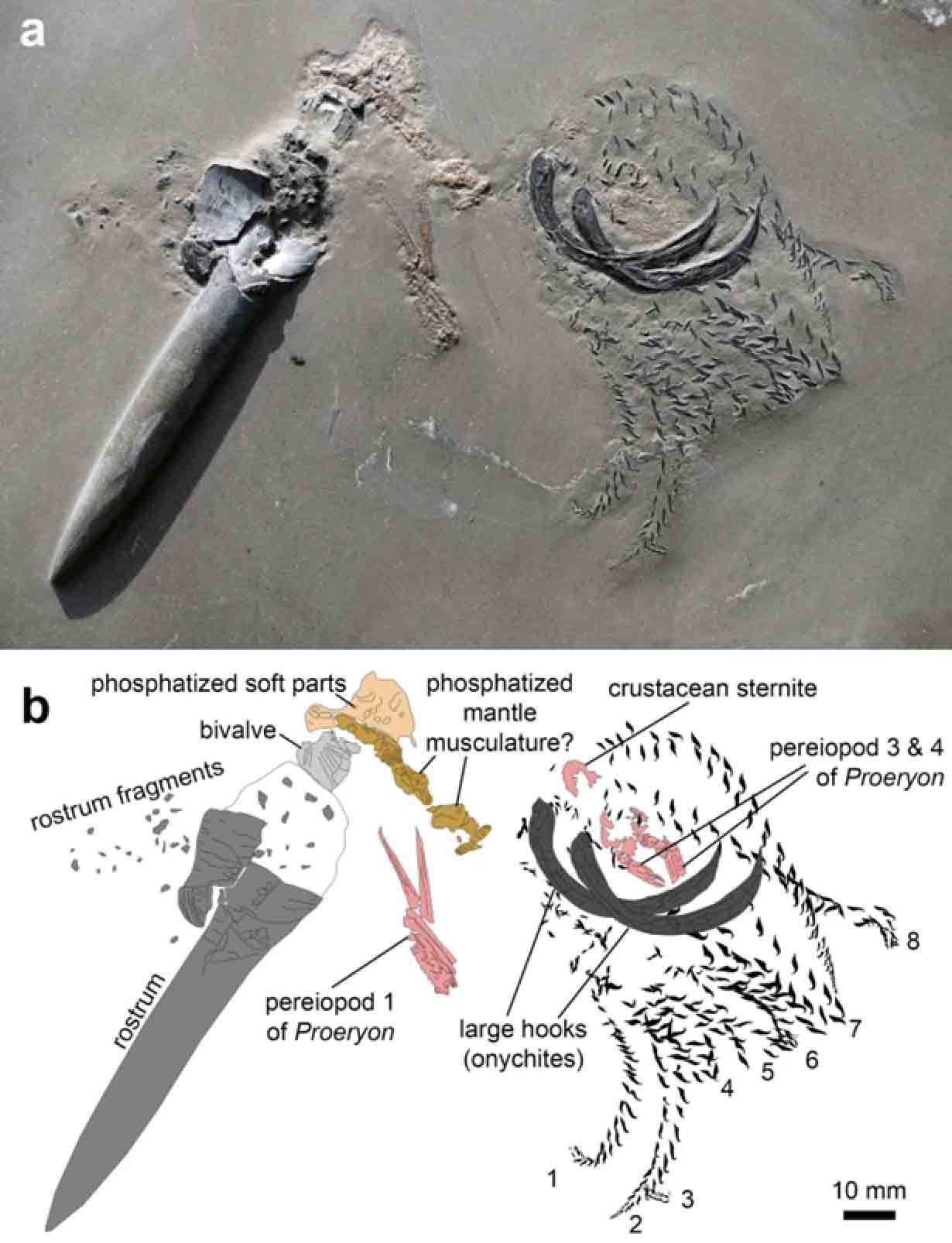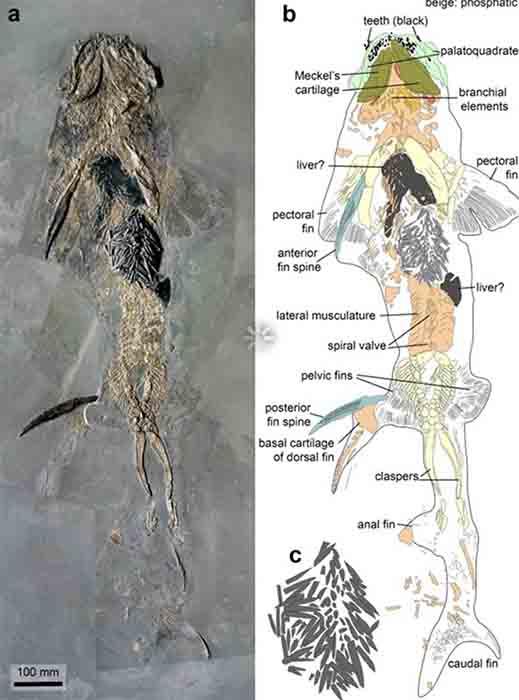
Epic Jurassic Era Fossil Shows a Predator in Action Being Preyed Upon
The Jurassic was a geological epoch that is dated from 201.3 million years ago (from the end of the Triassic period) to 145 million years ago (till the Cretaceous period begins) that has a long history preserved in fossils. Scientists and archaeologists have recently interpreted a 180-million-year-old Jurassic era fossil. Discovered back in 1970 by an amateur fossil collector, this unique Jurassic era fossil has yielded new insights into the food chain of prey and predators during this period.
The fossil shows a squid-like creature in the midst of devouring a many-tentacled crustacean, when a shark-like creature interrupted its meal, and killed it instead. This interpretation is the result of an insightful new study published in the well-known Swiss Journal of Palaeontology. While the shark swam away, the crustacean and the squid sank to the bottom of the sea in modern-day Germany, where they fossilized, as detailed in Live Science.
Studying the Jurassic Era Fossil: Predator and Prey
The lead researcher on the study, Christian Klug, is a curator at the University of Zurich’s Palaeontological Museum, and a professor at the Palaeontological Museum of the same university. He describes the early Jurassic fossil as “unique” and as “one of 10 specimens of belemnites with well-preserved soft tissues worldwide,” in an email exchange with Live Science.

a) A photo of the Jurassic era fossil specimen and its prey. b) Camera lucida drawing based on a). (Swiss Journal of Palaeontology)
The specimen also shows how predators sometimes become prey themselves. "Predators tend to be happy when they are eating, forgetting to pay good attention to their surroundings and potential danger. That might explain why the belemnite got caught, but there is no proof for that."
- The Earliest Known Human Ancestor is a What?!
- World’s First Complete Dinosaur Skeleton Has Been Vividly Brought to Life
The squid-like cephalopod animal is called a belemnite (now extinct) and had ten arms and two fins. Its demise has shed new light on many fascinating aspects, including the food chain hierarchy in the Jurassic period, according to the scientists and palaeontologists associated with the study.
The shark-like creature, in all probability, was a large predatory fish (perhaps the Hybodus), or an ancient crocodile, or a shark itself, but this isn’t, at present, entirely clear.
"We suggest that this represents remains of a meal of a vertebrate predator, possibly of the Early Jurassic shark Hybodus hauffianus. This is remarkable, because it informs about the behavior of a cephalopod and a vertebrate predator,” the study authors noted.

The early Jurassic elasmobranch Hybodus hauffianus (a kind of shark likely) with its stomach clogged by belemnite rostra. Photo (left) copyright of R. Böttcher / Staatliches Museum für Naturkunde in Stuttgart. (Swiss Journal of Palaeontology)
Pabulite Kill Leftover Evidence and the Food Chain
The focus on the food chain is not just because the predator got preyed upon, but also because of another potential evolutionary facet.
All cephalopods, in general, have tough rostra or beaks that are hard, pointed and difficult to digest. Fossils from the same period of marine crocodiles and predatory fish, and their stomachs, point to the fact that they were not discerning eaters, gobbling everything down, even the hard beaks.
This has been gauged from the remains of a fossilized shark (another Hybodus hauffianus), from the early Jurassic, also found in Germany. It had a stomach full of undigested belemnite beaks, which likely caused its premature and untimely death.
According to Klug, the hauffianus in contention “possibly ran into a swarm of belemnites and got too enthusiastic about it: It ate about 200 of them but forgot to bite off the rostra [beak-like mouthpart], thereby clogging its stomach, which eventually killed it.”
The predator from the fossil in the study had the sense to bite only the squishy middle part and leave the rest, showing a clear evolutionary trait. This is why the fossil inspired a new term (used in the title of the study as well): “pabulite.” This emerges from the Latin pabulum meaning food, and lithos, which means stone. Pabulites refer to the leftovers of the meal that never entered the predator’s digestive tract. A pabulite “provides evidence for incomplete predation.”

This Harpoceras falcifer was found in the Posidonia shale at Holzmaden, Baden-Wuerttemberg, Germany, which was the same source for the fossils used in the latest study. Harpoceras, an extinct genus of cephalopod, existed in the Jurassic period, and were fast-moving nektonic carnivores. (Lysippos / CC BY-SA 3.0)
A Fossilized History from a German Stone Quarry
The Jurassic era fossil focused on in the study was originally discovered in 1970 by an amateur fossil collector, Dieter Weber, who found the specimen in a small quarry near Holzmaden, near Stuttgart in southwestern Germany.
A co-researcher of the study, Gunter Schweigert, who is the curator of Jurassic and Cretaceous invertebrates at the State Museum of Natural History Stuttgart (SMNS), chanced upon the specimen while paying Weber’s collection a visit in 2019. Schweigert pushed the SMNS to purchase the fossil shortly afterwards.
- Kazakhstan Valley Filled with Giant Balls Has Geologists and Fringe Scientists Butting Heads
- Ancient Sea Monsters: Misidentified Fossilized Skeletons Now Revealing Hidden History of Ichthyosaur
Both specimens, the belemnite and the crustacean (from the genus Proeryon), were still embedded in the fossilized sediment. The crustacean had a body reminiscent of a lobster with long and thin claws, but its fossil was not in the best condition. The belemnite, on the other hand, apart from the squishy middle that had been taken away by the predator in question, was in excellent condition.
This could be because once the creature sank to the bottom of the ocean, fewer scavengers were able reach it. Additionally, ocean currents are also very weak at the bottom of the sea, causing it to sink and remain in one place over millions and millions of years.
Moving forward, palaeontologists are eager to discover more Jurassic era fossils, as they help shed light on the intricate (and relatively unknown) Jurassic food patterns, webs, and chains.
Top image: This artist’s image from a recent study of a Jurassic era fossil shows the predator squid becoming prey to an ancient shark-like creature. Source: Swiss Journal of Palaeontology
By Rudra Bhushan
References
Geggel, L. 2021. Jurassic squid got murdered mid-meal, leaving this epic fossil behind. Available at: https://www.livescience.com/jurassic-seafood-fossil.html.
Klug, C., Schweigert, G., et al. Fossilized leftover falls as sources of palaeoecological data: a ‘pabulite’ comprising a crustacean, a belemnite and a vertebrate from the Early Jurassic Posidonia Shale. Swiss Journal of Palaeontology, 140. Available at: https://doi.org/10.1186/s13358-021-00225-z.
Marshall, M. 2021. Fossil shows a shark eating a proto-squid as it ate a crustacean. Available at: https://www.newscientist.com/article/2276499-fossil-shows-a-shark-eating-a-proto-squid-as-it-ate-a-crustacean/.
Yirka, B. 2021. Fossil of ancient squid eating a crustacean while being eaten by an ancient shark. Available at: https://phys.org/news/2021-05-fossil-ancient-squid-crustacean-eaten.html.















